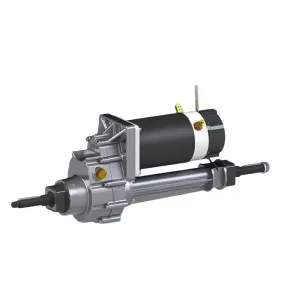Automatic transmissions and transaxle systems are essential components of modern vehicles, providing the convenience of seamless shifting and efficient power distribution. These systems are made up of multiple complex components that work together to ensure smooth and reliable operation. In this article, we’ll explore the three main parts of automatic transmission and transaxle systems, clarifying their function and importance to the overall vehicle performance.
Torque converter:
The torque converter is a key component of the automatic transmission system. It acts as a fluid coupling that transfers power from the engine to the transmission, allowing the vehicle to come to a complete stop without causing the engine to stall. The torque converter consists of three main components: impeller, turbine and stator. When the engine is running, an impeller connected to the engine crankshaft rotates and creates a flow of transmission fluid. This fluid is then directed to a turbine connected to the transmission input shaft. As fluid flows from the impeller to the turbine, it causes the turbine to spin, transmitting power to the transmission.
The stator is located between the impeller and turbine and plays a vital role in changing the direction of fluid flow to increase torque output. This process enables the vehicle to accelerate smoothly and efficiently. In addition, the torque converter also provides a certain amount of torque multiplication, allowing the vehicle to easily start from a standstill. Overall, the torque converter is an important part of the automatic transmission system, ensuring seamless power transfer and smooth operation during gear changes.
Planetary gear set:
The planetary gear set is another fundamental component of automatic transmission and transaxle systems. It consists of a set of gears that work together to provide different transmission ratios, allowing the vehicle to shift gears automatically. The planetary gear set consists of three main elements: the sun gear, the planet gears, and the ring gear. These components are arranged in a way that allows them to interact and produce different gear ratios, promoting smooth acceleration and efficient power transfer.
When working, the input shaft of the transmission is connected to the sun gear, and the planet gears are mounted on the planet carrier and mesh with the sun gear and ring gear. As the input shaft rotates, it drives the sun gear, causing the planet gears to rotate around it. This movement in turn drives a ring gear connected to the transmission output shaft. By changing the speed and direction of rotation of these components, a planetary gear set can create different gear ratios, allowing the vehicle to shift gears seamlessly when accelerating or decelerating.
The planetary gear set is controlled by a series of clutches and bands that engage and disengage to select the appropriate gear ratio based on the vehicle’s speed and load. This complex system of gears and clutches allows the automatic transmission to provide smooth, efficient power transfer that enhances the overall driving experience.
Hydraulic system:
The hydraulic system is a key part of the automatic transmission and transaxle system, responsible for controlling the operation of planetary gear sets, torque converters and other components. It uses transmission fluid to actuate various clutches, belts and valves, allowing for precise, timely shifting. Hydraulic systems consist of a network of pumps, valve bodies, and fluid channels that help distribute and control transmission fluid throughout the system.
The pump is driven by the engine and is responsible for generating hydraulic pressure within the system. This pressure is critical for engaging the clutch and band and controlling the position of the valve within the valve body. The valve body acts as the control center for the hydraulic system, directing transmission oil flow to the appropriate clutches and belts based on vehicle speed, load and driver input.
In addition to controlling gear changes, the hydraulic system also plays a vital role in regulating the operation of the torque converter, ensuring smooth and efficient power transfer between the engine and transmission. By regulating the flow of transmission fluid, the hydraulic system enables the automatic transmission to provide seamless shifting and optimal performance in a variety of driving conditions.
In summary, automatic transmission and transaxle systems consist of several important components that work together to provide seamless shifting and efficient power distribution. The torque converter, planetary gear set and hydraulic system are components that play an important role in the overall performance of the transmission. Understanding the function and importance of these components is critical to maintaining and troubleshooting automatic transmission and transaxle systems and ensuring reliable and smooth operation of the vehicle.
Post time: Aug-02-2024


